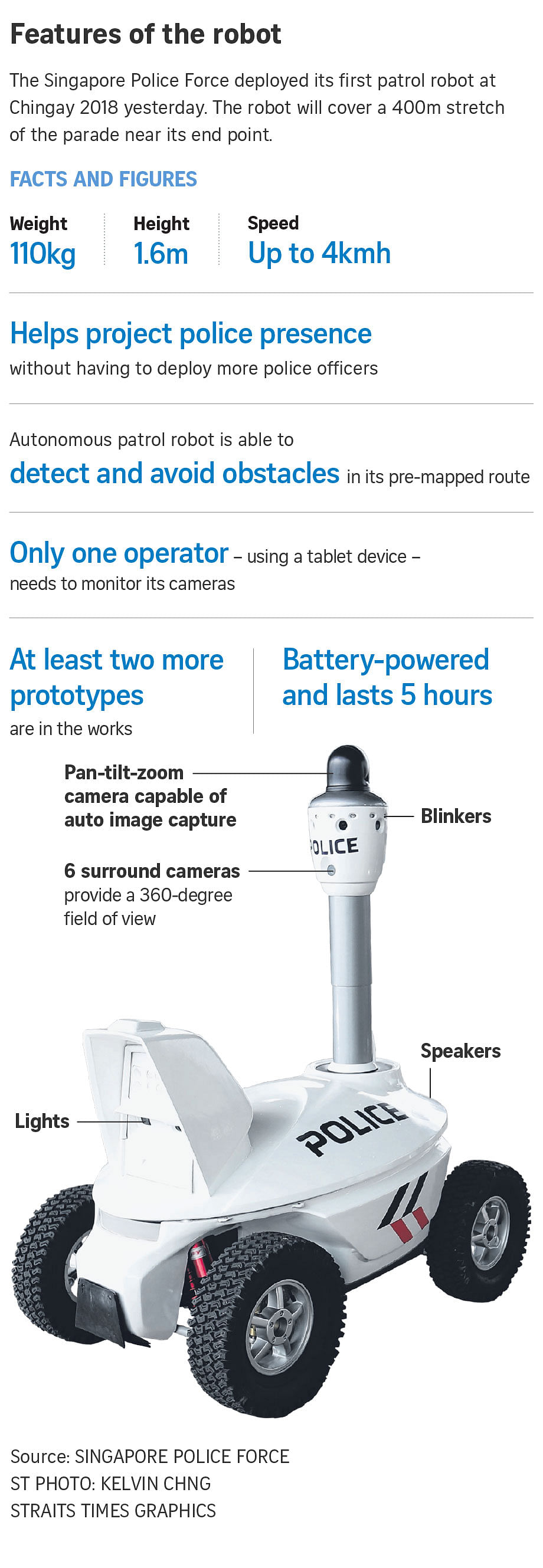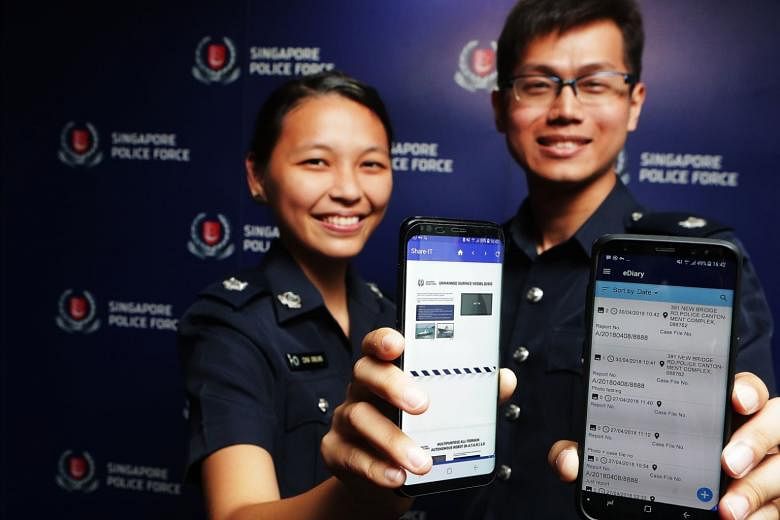SINGAPORE - New technology unveiled on Thursday (May 3) will make it easier for the police to fight crime and enforce the law.
Souped-up smartphones will allow officers to respond faster and more effectively to incidents, as well as call up key information on a case. Robots on patrol can aid in the detection of suspicious activities, and handheld scanners will make it easier to take real-time 3D scans of crime scenes to aid in crime solving.
These technologies were presented by Law and Home Affairs Minister K. Shanmugam at the Singapore Police Force's (SPF) annual workplan seminar on Thursday.
The police smartphone will allow officers to receive real-time information on the ground 24/7.
"They will be able to make better and faster decisions, more effective response on the ground," said Mr Shanmugam at the seminar at the Singapore University of Technology and Design in Upper Changi.
From next March, 8,000 front-line police officers will be able to use police-issued smartphones when they respond to incidents and in engaging the public.
The phones will come with custom-built SPF apps that will be hosted on a secure platform.
A police spokesman said a police-issued phone would ensure that officers use devices with adequate security designs, as opposed to having them download apps on their personal phones, which could vary in model and security configuration.
Currently, officers use bulky mobile data terminals to send and receive messages from their command centres. To communicate with fellow officers on the ground, they have to use their own phones to make calls and are not allowed to transmit case information via normal messaging apps.
But with the police smartphone, they will be able to perform the functions of calling, messaging and incident report filing all on one platform.
The phones will also enable officers to access information on standard operating procedures on the go, en route to an incident and even while they are off duty.
Through apps such as the CCTV Mapping app, officers can plot locations of interest, for example, those of closed-circuit television cameras and construction sites, and use this information for investigations.
For instance, the location of CCTV cameras can help investigation officers identify which cameras would have likely captured footage of a suspect.
Some apps will also allow officers to identify uniforms that suspects might be wearing. In the future, officers will be able to pull up information about a suspect's criminal record.
Administrative apps will allow officers to electronically file case entries that will be uploaded into the case management system.
Should the device be lost, security measures, such as allowing the information to be remotely deleted, will be carried out, the police said in response to media queries.
In addition to strict security measures and standard operating procedures, access and use of the police smartphone and its apps will be monitored closely, and any misuse will result in disciplinary proceedings against the officer involved, said the police spokesman.
So far, about 700 officers from the Central Police Division have been issued the smartphones.
Mr Shanmugam said harnessing technology has become essential for the authorities to do their job, for example, in surveillance and sense-making.
"Today, more than 2,000 cases have been solved by the use of cameras. It has reduced substantially the number of unlicensed moneylending type of acts," he said.
About 70,000 cameras have been installed so far. This year, another 5,000 cameras will be installed, with greater use of video analytical capabilities.
Mr Shanmugam cited China as a leader in the use of closed-circuit television surveillance.
It has one of the largest CCTV networks in the world. Its cameras have facial recognition technology and are deployed at various places, including concerts and festivals, Mr Shanmugam added.
A suspect wanted in a major Chinese city was nabbed about 7,000km away after such cameras picked him up at a Jacky Cheung concert among 60,000 people, said Mr Shanmugam, referring to a news report.
"That is the kind of power that technology can give to law enforcement officers.
"Our capabilities must similarly be that if something happens, we want to trace the person, we need to have complete real-time capabilities. Where is he? What is he doing? Which car is he getting into? Which carpark?"
The minister added: "We are not there yet. We have to get there."
Addressing officers at the seminar, Mr Shanmugam reiterated the high levels of public trust shown in the 2016 Public Trust Perception Survey, where 91 per cent of those surveyed said they felt that the police are well respected by the community.
"Public trust forms the bedrock of our policing. We have seen in other countries how easily trust in police can break down. When that happens, law and order break down too."
He also spoke about the Public Order and Safety (Special Powers) Bill that was passed in March. The new law empowers the police to enforce a communications stop order in the event of a terror incident.
The new law came under opposition from some civil society groups who took issue with its definition of "serious incident".
A survey conducted by government feedback unit Reach showed that 82 per cent of the 1,038 polled supported the Public Order and Safety (Special Powers) Act, said Mr Shanmugam.
Going high-tech on the front line
The Singapore Police Force will be deploying these technological initiatives to enhance front-line operations:
Police smartphone
The Android phones come with custom-built SPF apps and will allow officers to respond more effectively, even when they are off duty. The apps will help in areas such as incident management, administrative and training functions, and public engagement.
Multi-purpose, all-terrain, autonomous robot

Sound and visual sensors, with 360-degree video capability, allow the autonomous patrol bot to detect suspicious activity on the ground. The robot was deployed in an in-house trial in late 2017, and there are plans to include video and audio analytics in its arsenal.
It was developed through partnership with the Home Affairs Ministry's Office of the Chief Science and Technology Officer and the Agency for Science, Technology and Research's Institute for Infocomm Research.
S5 pan-tilt-zoom patrol robot
The robot was first deployed during Chingay 2018 for crowd patrol to enhance event security. It can patrol autonomously and provide live video feed to a command post.

3D handheld scanner

A lighter and more convenient alternative to the existing terrestrial laser scanner, the 3D handheld scanner comes with in-built software that can instantly create a 3D image of the crime scene. It is more mobile than existing 3D scanner technology that currently requires supplementary software and has to be mounted on a tri-pod. It will go on trial this month.
Future robot - display
Used for outreach and public engagement, the interactive touch-screen panel that comes with a "human" face has been used for information sharing at roadshows. It can respond to movement and sound, and will aid officers during outreach events.







